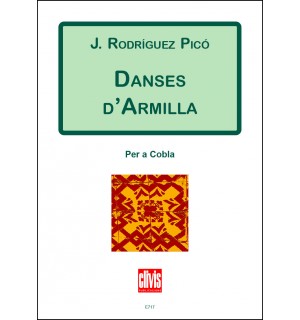
No products
Prices are tax included
Product successfully added to your shopping cart
There are 0 items in your cart. There is 1 item in your cart.
- English
- Castellano
- Català
Danses d'Armilla
E717
New product
Taking advantage of the characteristics of cobla instruments, the composer moved away from the initial concept of the music for open spaces and conceived the work to be played in a concert hall, with orchestration featuring small solo instruments combined with the depth of sound typical of thecobla.
| Period | XXth Century |
| Instruments | Cobla |
| Pages | 61 |
| Time | 20 min. |
| Contents | score |
| ISMN | 979-0-3502-0803-4 |
| Remarks | The particellas are available in rent regime. Contact with the publisher (info@clivis.cat). |
| Edition | Printed |
In Thin Cities 3 from Le città invisibili*, Italo Calvino wrote: “...the streams of water channelled in the pipes of Armilla have remained in the possession of nymphs and naiads.”
Continuing the series of compositions suggested by Calvino’s book, the Dances of Armilla have an almost chamber-like timbre associated with the element of water that characterises the town of Armilla, understoodin the sense of a stream of clear, spring-like water given by Gaston Bachelard.
As in the previous Dances, in the Dances of Armilla we find a prevailing rhythmic element suggested by the aquatic nature so characteristic of Armilla; the rhythm is close to Sicilian.
Taking advantage of the characteristics of cobla instruments, I moved away from the initial concept of the music for open spaces and conceived the work to be played in a concert hall, with orchestration featuring small solo instruments combined with the depth of sound typical of the cobla.
Jesús Rodríguez Picó
*Les ciutats invisibles, Italo Calvino, Editorial Empúries, Barcelona 1985







